![]() (1)
(1)
I.N.
Trofimova, A.B. Potapov
Keldysh Institute of Applied
Mathematics
Moscow, Russia
W.H.
Sulis
Departments of Psychiatry,
Psychology, and Computer Science
McMaster University, Hamilton,
Ontario, Canada L8S 4K1
Abstract: The impact of formal characteristics of population dynamics on individual behaviour was studied through the use of a random graphical dynamical model. In this model, individual agents attempted to minimize the costs associated with the establishment of cooperative links with neighboring agents. These costs varied according to the 'compatibility' between agents. The links were dynamic, changing with fluctuations in costs. Population size, compatibilities, sociability and contact rate were tunable parameters. A phase transition was observed as a function of sociability with the critical point Sc=P0,6, where P is the population size. Below Sc, the population organized into a large number of small connected clusters. Above Sc, the population organized mostly into a single large cluster. Such behavior appears to be a group effect, independent of individual characteristics.
Keywords: group dynamics, affiliation, compatibility,
individual behavior, random graphs, phase transitions.
INTRODUCTION
Sociologists and historians have attempted to understand the formation and dissolution of large groups, populations and states through an explication of the economic and political conditions which are presumed to be present at the time of their formation, together with the identification of some seminal individuals around whom such collectives crystallize. Sociobiologists and ethologists have looked to inherited tendencies as their explanation of these phenomena. Social psychologists, in addressing similar issues, have explored in detail the patterns of interactions within groups, the effects of group size, conformism, affiliation, group identification, social contagion, social differentiation and anchoring. Psychiatrists and psychoanalysts have devoted considerable effort to understanding the interaction between social milieu and the biological foundations of individual behavior.
In spite of many decades of research, several seemingly fundamental questions remain unanswered. To whit:
Many studies have been conducted which explore the effect that individual differences in behavior have upon the nature of group dynamics. But what about the flip side? What role does group dynamics play in the expression of behavior by those individuals who make up the group?
And if group dynamics does influence individual behavior, then what freedom does an individual have to make choices and express their individual personality and wishes?
Much of the current research into group dynamics presumes
that such dynamics is merely an expression of the behaviors and characteristics
of the individuals which make up the group. In contrast, our thesis is
that groups possess dynamical properties which exist, to a large extent,
independent of the nature of the individuals which comprise the group.
This present paper is devoted to demonstrating the presence of universal
behavior in a model of group dynamics, and therefore the presence of dynamical
behavior within a group which is largely independent of individual characteristics.
BACKGROUND
The synergetics approach (Haken, 1984, 1989) has demonstrated that large collectives, whether complex materials, societies or brains, may be analyzed globally and are indeed more than merely the sum of their parts. Local interactions among the individual members of the collective result in the emergence of long term correlations in the behaviour of these individuals. These correlations in turn give rise to order parameters- macroscopic variables which describe the global behaviour of the collective. These order parameters are frequently 'slaved' to other control parameters which may be externally modified to influence the global behaviour of the collective. The existence of order parameters significantly reduces the degrees of freedom of a system and thus the number of parameters required for an effective description. Moreover these order parameters frequently demonstrate evidence of universality, that is, properties which hold across a wide range of models and which are more or less independent of the nature of the individual units from which the model is constructed.
The most striking example of such universality involves so-called second order phase transitions. These transitions involve the continuous transformation of a system from one phase or state into another, as some parameter is varied. We are all familiar with such transitions - the melting of ice into water as the temperature increases provides a prototypical example. Wilson (1971) discovered that certain quantitative relations which describe the behavior of such systems near the transition point depend only upon the formal character of the local interactions between the constituent agents, i.e. whether the effect could be described via scalars, or vectors, or tensors, etc. These relations did not depend upon the fine details or material form of these interactions. As a consequence, these relations, and the behavior which they described, were universal for a large class of systems.
First demonstrated theoretically and later in simulations, this form of universality has been observed experimentally in a large number of physical systems. With the advent of complex systems theory there have emerged a number of models which appear particularly promising for exploring questions of interest to psychology. These models include cellular automata, boolean networks, neural networks, and iterated games. It appears natural to explore these models for evidence of universal behavior which might then be sought in social systems.
The classical concept of a phase transition arises from equilibrium thermodynamics. Equilibrium states corresponding to different values of the thermodynamic parameters are distinguished by virtue of distinct macroscopic properties, such as the solid, liquid, and gaseous states of water. Fluctuations are minimal in the equilibrium condition, and so these states may be viewed as more or less static, corresponding to very small regions of the microscopic state space.
Recently, the notion of a phase transition has been generalized to include nonequilibrium dissipative systems (G. Nicolis & I. Prigogine, 1977) and nonequilibrium systems in rapidly fluctuating environments (W. Horsthemke & R. Lefever, 1984). The latter has given rise to the concept of a stochastic phase transition. Such a transition is reflected, not in a qualitative change in the dynamics or in the states, but rather in a qualitative change in the statistical structure of the system. Under conditions of large fluctuations, different parameter values cannot be distinguished by virtue of their attracting sets since the system wanders over the entire state space. Instead one must look to the stochastic structure which is imposed upon the state space by the dynamics of the system. Thus the objects of interest are not the states of the system, but the probability distribution functions over these states.
An entire new subdiscipline of artificial sociology (J.M. Epstein & R.L. Axtell, 1996) has begun to emerge, similar to those of artificial intelligence and artificial life. Several studies have demonstrated the existence of transitional behavior in social groups. Huberman and Glance (1993), using an iterated game theoretic model, considered a scenario in which individuals could either chose to cooperate in the production of some good, or to refuse to do so, based upon a knowledge of the current global production of the good, together with individualized expectations about future production. The individual agents had no knowledge about the activity or characteristics of neighbouring agents, nor did they interact with them. The agents were able to modify their strategy as a result of past performance. They found that for small populations, the group would evolve into a homogeneous collection of cooperators. For large populations, the group evolved into a homogeneous collection of non-cooperators. The size of the metastable region between these two states varied as a function of the uncertainty associated with each individual's expression of their choice. Diversity was modeled as a distribution of such uncertainty throughout the population. Such diversity shortened the time to transition, but did not alter the critical points at which such transitions occurred.
Although this model did demonstrate the existence of transitional behavior, which suggests the presence of universality, there are several problems. First of all, it is not a model of social interaction since, strictly speaking, no interaction between agents takes place. Agents are limited to only two choices, with diversity occurring not in the range of choices, but merely in the expression of choices. The populations studied were extremely small, and the time scale over which these transitions occurred was very large. One strength of the model however was its amenability to formal analysis.
Weidlich (1994) developed a stochastic model of political structure which demonstrated a similar phase transition within societies, resulting in a shift from a predominantly democratic society to a predominantly totalitarian society. Like the Huberman and Glance model, interactions played a minimal role.
In actual social groups, however, the individuals who
comprise the group interact with one another. These interactions are generally
of a transient nature with the individuals frequently seeking out partners
on the basis of some form of compatibility, which may be of a transient
nature relevant to the problem at hand, or may be longer lasting. Diversity
is strong, and the populations are generally large, especially in the case
of crowds, mobs, or societies. Trofimova et.
al. (1997) have introduced several
models in which interaction and diversity play fundamental roles. This
work demonstrated the plausibility of seeking universal behavior in group
interactions and has led to the present study.
The Compatibility Model
No model can embrace the full complexity inherent in naturally occurring social groups. We chose therefore to focus upon the connection structure of the group, which is critical for understanding the flow of information within the group, and therefore, presumably, for determining its eventual behavior. Our agents possess an abstract set of characteristics, and seek to form connections with other agents according to the degree of compatibility between these characteristics. Such characteristics need to be interpreted broadly and may be economical, physical, psychological, social, aesthetic, intellectual, or informational. Each connection carries with it a relative valuation on the part of the agent forming it, and the agents attempt to optimize their valuations over time. This results in a highly dynamic connection structure.
The compatibility model is a random graphical dynamical system with features reminiscent of spin glass models. We consider an ensemble of N cells, each of which possesses a "resource of life" R, and a k-dimensional "vector of traits" v, where each component can equal +/- 1. Each cell forms connections with other cells, and both the maximal number of connections per cell S, termed the `sociability' and the rate of connection attempts a are fixed and identical for all cells.
Time is discrete, and at every time step each cell i attempts a random connections, and its life resource Ri is adjusted according to the ``quality" of its current connections. If Ri>0, the cell dies, to be replaced by a new cell having the maximal life resource R and a random vector of traits. The quality of a contact between i-th and j-th cells is evaluated according to the traits of both cells:
![]() (1)
(1)
where ( , ) denotes the inner product of two vectors, Tij is the duration of the contact between the cells i and j, and s (T) is the "efficiency of the contact" - for small T it linearly increases, and after several time steps saturates at s =1. The quality varies between sk for aligned trait vectors, to -sk for anti-aligned trait vectors. For cell i having ni connections and connection set {im},the value of the life resource at the next step is
![]()
![]() ,(2)
,(2)
Thus high quality connections result in a longer life.
Connections are adjusted as follows. At each time step, a cell i is randomly chosen and a possible contact cell j, which is not a member of the connection set of i is randomly selected. The possible profit of this connection for both i and j is determined by calculating the effect of this connection on the calculation of d(ni,{im}) and d(ni,{jk}). If the effect is beneficial to both i and j then the connection is formed and added to the connection sets of both i and j. If the number of connections in either set is submaximal, it is simply added to that set. Otherwise the least profitable connection is deleted prior to adding the new connection. This process is repeated a times so that the number of new connections formed depends upon their profitability.
The compatibility model was simulated for 2000 time steps
with a contact rate of 4, life resource of 100 and trait vector of dimension
8.
RESULTS
The major object of interest is the formation of clusters: sets of agents linked together by virtue of a chain of mutual connections. Clusters as considered here correspond to connected components in the usual vernacular of graph theory. The choice to focus upon clusters is two-fold. First, clusters represent collections of agents which are functionally interconnected and therefore capable of interaction with one another. This capacity for interaction is a fundamental prerequisite of any dynamical model and so the formation of clusters is of fundamental importance to virtually any systemic modeling. Second, there already exists a rich a detailed literature on the formation of clusters in a variety of different settings, most notably the theory of random graphs, percolation, and spin glasses. These models have all demonstrated universal behaviour as regards particular aspects of cluster formation and so the formation of clusters here provides a natural starting point in the search for universal behaviour in systemic models. Since the connections between agents were dynamic, only those clusters which persisted for more than 3 time steps were singled out for analysis.
In the compatibility model, the connections between agents
proved to be highly dynamic, without any apparent asymptotic limiting behavior.
Large fluctuations in connection structure occurred for all parameter values.
Nevertheless, the model did appear to exhibit stationary statistical behavior.
Thus we studied the distribution of cluster sizes for varying values of
the parameters.
| a) Sociability 10 | b) Sociability 20 | |
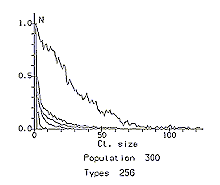 |
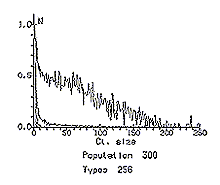 |
|
| c) Sociability 30 | d) Sociability 41 | |
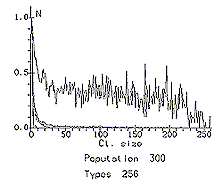 |
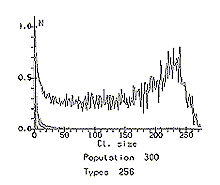 |
|
| e) Sociability 50 | f) Sociability 70 | |
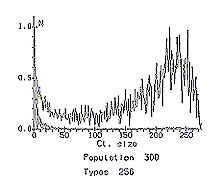 |
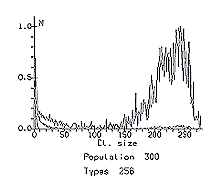 |
Figure 1. Cluster Distribution Functions. The y-axis represents number of clusters normalized against the mode.
To simplify the analysis, we considered only those clusters which persisted for more than 3 time steps. This reduced the fluctuations somewhat. The size and number of such clusters were determined during the course of the simulation. Data on numbers of contacts, numbers of deaths, average cell age, number of clusters, maximal cluster size and mean cluster size at each time step was also collected and will be discussed in a subsequent publication; here we focus our attention upon the transitional behavior of the cluster distribution.
Figure 1 illustrates the distribution of clusters obtained during a 2000 time step run, for a population of 300 agents, for a variety of sociability levels. It is readily apparent that a dramatic qualitative change in the dynamics of this system occurs as the sociability is allowed to increase. For low values, the distribution of clusters is highly skewed in favour of the formation of small clusters. The distribution is roughly exponential. At high values, the distribution becomes highly skewed in favour of large clusters. Here it takes the form of a skewed Gaussian. For intermediate values, the distribution becomes almost uniform.
In order to more easily study this change, we introduce an order parameter A, termed the affiliation of the group, which we define as the ratio of the mode of the distribution to the maximum generated cluster size. This order parameter is close to 0 when the distribution is highly skewed towards small clusters, and close to 1 when it is skewed towards big clusters.
Figure 2 shows the distribution of A as a function of population size and sociability. Population lies along the y axis, sociability along the x axis, and affiliation along the z axis. For low populations, the affiliation appears to increase more or less monotonically as a function of the sociability. The transition from a preponderance of small clusters, reflected in a low affiliation, to a preponderance of large clusters, reflected in a high affiliation, appears to be a continuous phase transition (R.G. Lerner & G.L. Trigg, 1981). For larger populations, the transition occurs more abruptly. For example, at a population of 300, the affiliation remains at about 0.01 for sociabilities up to and including 40. However at a sociability of 41, the affiliation jumps abruptly to 0.82.
The appearance of this transition depended upon the observation time, and the duration of the simulation, mostly notably at the higher population levels. No such transition occurred for a population of 1000 agents when the duration was limited to 2000 time steps, but it did appear after 5000 time steps. Interestingly no such transition appeared for a population of 2000 agents over durations up to 10000 time steps. This suggests that the minimal observation time grows nonlinearly with population size.

Figure 2. Affiliation Landscape. The lines demonstrate the affiliation as a function of populations and sociability
The transitions occurred regardless of whether all agents were initialized with identical life spans, or with randomly assigned life spans.
An alternative view of the transition is illustrated in
Figure 3, which shows the entropy of the cluster distribution functions
as a function of the sociability for a population of 300 agents. The entropy
of a discrete probability distribution f is given as
It was not possible, given the limits of resolution of the simulation, to determine the critical point accurately. We calculated the entropy for each distribution function for each of the populations and then estimated the maximal value. From this we were able to estimate the critical sociability as Sc=P0,6 . The clusters are highly volatile. Virtually no clusters survive intact for more than 18 time steps. Survivability depends weakly upon the sociability. For example, for a population of 300, below the critical point at a sociability of 20, the largest cluster surviving to 9 time steps was 220. Above the critical point, at a sociability of 90, the largest cluster surviving to 9 time steps was only of size 5.

There is a weak effect of diversity and contact rate upon the order parameter. In particular, there is a tendency for the transition to take place at lower sociabilities for low contact rates and for high diversities. This effect seems to weaken withhigher contact rates. This result was quite surprising and will be explored in greater detail in a subsequent publication.Figure 3. Transition of Entropy and Affiliation as a Function of Sociability.
DISCUSSION
Dynamical Aspects
The compatibility model exhibits
a stochastic phase transition in the distribution of cluster sizes as function
of the sociability. For low populations, this transition bears many of
the features of a continuous phase transition. There is a gradual increase
in the order parameter across the transition. The entropy of the distributions
gradually increases, reflecting a uniformization of the distribution, and
thus a less ordered state, and then gradually declines again, reflecting
a transition to a more ordered state. For large populations, the transition
becomes more abrupt. The affiliation shows a very sharp transition from
a level near 0 below a critical value, to a level close to 1
above this critical value. This second critical value occurs later than
the critical value determined by the entropy. We estimated it to be ![]() .
The discontinuous nature of the change in affiliation suggests a first
order transition, yet the entropy continues to show the rise and fall typical
of the continuous transition. Given the resolution limitations of the present
simulation, it is not possible to determine whether the discontinuous nature
of the affiliation transition is merely a finite size effect, or whether
indeed there is a shift in the qualitative nature of the transition from
continuous to discontinuous in the infinite limit. More detailed studies
need to be carried out but clearly it is an intriguing possibility.
.
The discontinuous nature of the change in affiliation suggests a first
order transition, yet the entropy continues to show the rise and fall typical
of the continuous transition. Given the resolution limitations of the present
simulation, it is not possible to determine whether the discontinuous nature
of the affiliation transition is merely a finite size effect, or whether
indeed there is a shift in the qualitative nature of the transition from
continuous to discontinuous in the infinite limit. More detailed studies
need to be carried out but clearly it is an intriguing possibility.
Continuous phase transitions have been extensively studied and two well known models, percolation models (Grimmett, 1989) and random graph models(Palmer, 1985) bear a striking similarity to the compatibility model. In all of these models, connections are established between a collection of vertices. The difference between the models lies mostly in the fact that in percolation and random graph models, the connections, once established, are fixed, as are the vertices. Thus the percolation and random graph models simulate equilibrium conditions. In contrast, connections in the compatibility model are highly dynamic with large fluctuations occurring for all values of the sociability. An equilibrium model is inappropriate for understanding such a situation. Nevertheless, as these models provide analytical results, they serve as a useful benchmark against which to compare the behavior of the compatibility model.
The qualitative behaviour of both random graph and percolation models is determined by a critical parameter, c. In the case of random graphs, for values of c below a so-called critical threshold, the maximal cluster size is on the order of log n, where n is the total number of vertices. At the critical threshold, there is a significant jump is maximal cluster size, to the order of n2/3. Beyond the critical threshold, the maximal cluster size approaches order n. Percolation models show similar qualitative behaviour.
For the compatibility model, n=P. Observation shows that below the critical point, the maximum cluster size is approximately P/2, significantly larger than log P. Beyond the critical point, the maximal cluster size approaches P, just as for percolation models..
For the random graph model, c=pn/2, where p
is the probability of an edge occurring. The critical value of c
is 1. Translating this into the compatibility model, one finds that the
critical parameter would be ![]() if the dynamics were similar to that for percolation. In this case the
critical point would occur at S=2 and be independent of population. This
stands in marked contrast to the empirical formula for the critical point
which was given as P0,6 . Thus the dynamic nature of
our model departs in a significant quantitative manner from standard percolation
and random graph models.
if the dynamics were similar to that for percolation. In this case the
critical point would occur at S=2 and be independent of population. This
stands in marked contrast to the empirical formula for the critical point
which was given as P0,6 . Thus the dynamic nature of
our model departs in a significant quantitative manner from standard percolation
and random graph models.
In addition, although we did not study this question in
detail, the apparent critical state of our model is characterized by a
probability distribution of high entropy, a close approximation to a uniform
distribution. Such a uniform distribution reflects a complete lack of structure
in the system, with clusters of all scales appearing with more or less
equal frequency. Such a state is maintained so long as the sociability
remains constant at the critical value. This situation is reminiscent of
that observed in so-called self organized criticality models (Bak,
Tang & Wiesenfeld, 1988).
Psychological Aspects
In this simple model, agents attempt to make and maintain contacts with other agents based solely upon their `compatibility', which in this case means their similarity to one another. The major tunable parameter was the agent's `sociability', that is the number of contacts which they are willing to sustain at any given time. We have observed that sociability is a critical parameter in determining the cohesiveness of a population. If the individuals making up a large group or population are sufficiently sociable, then they will establish a network of connections within the group which effectively link every individual member to every other. This cohesiveness arises regardless of the degree of similarity among the individuals making up the group, and, as our preliminary evidence shows, paradoxically the greater the diversity among the members, the more readily this coherence is established.
Note that our group does not demand conformity on the part of its members. Indeed, members maintain their individuality throughout the duration of the simulation. That being the case, what could this tendency towards coherence reflect? We suggest that such coherent linkages give rise to a sense of familiarity and community within a large group. Even if one recognizes that another individual possesses a temperament, character, personality, attitudinal or belief system different from our own, a stable link to that person will, over time, lead to a sense of familiarity, and the formation of, albeit weak, affiliational bonds. Such bonds, when they extend throughout a group or society could serve as the basis for the development of a sense of group or of national identity.
The concept of a national identity has long been a contentious one. Simplistic attempts to relate a group identity to shared personality traits, or to shared attitudes or beliefs, repeatedly fail in the face of the demonstration of the distributional character of these traits, attitudes, and beliefs. There is no common trait, attitude or belief. There is no 'average person'. Nevertheless, in spite of this diversity, the members of virtually every society or nation tend to see themselves as part of a coherent whole. We suggest that this sense of community arises out of the formation of affiliational bonds, and that this tendency to form such bonds is not an outcome of ideology, political will, nor the force of character of unique individuals, but is a fundamental dynamical property of any group in which members must form even fleeting relationships among themselves for the purpose of interaction and exchange. Moreover the critical factor is the degree of sociability of its members.
Historical contingencies play a major role is shaping the form that such a national identity will take, such as in the adoption of a socialist, communist, capitalist or fascist politics. But the basic underlying process responsible for the capacity for such global polities to arise is a universal of group dynamics. Thus our tendency to acquire such a social identity is not a manifestation of the influence of our personality upon the group, but instead is a reflection of the influence of the group upon our personality. Thus the tendency towards the adoption of totalitarian political structures, even in the so-called enlightened Western democracies, may be an expression of this deep group dynamic.
The situation in which the individuals within a society show little sociability leads to the formation of small groups, and effective isolation for a majority of the populace. In such a case, the society will express a rich diversity of traits, attitudes and beliefs, but will lack any sense of a coherent identity. With the trend towards so-called `cocooning', following the introduction of the personal computer, we have begun to witness a decline in socialization, particularly in the West. Is it possible that the gradual emergence of radical dissident splinter groups within the Western democracies is a manifestation, not of deep political schisms, but of our excessive emphasis upon the individual, leading to diminished socialization? Is the adoption of such extreme ideologies perhaps the result of diminished socialization, rather than the converse?
Two methodological points require emphasis. First of all, the transitional dynamics exhibited by this system is not observable through a single sample of the connection structure. Virtually any clustering is possible for any degree of sociability, and so a single sample tells one nothing about the dynamics of the group. Both the dynamics, and the transition, are observable only through repeated observations of the system over time, and a determination of the relevant distribution function(s). Second, the appearance of the transition can be observed only if the period of observation is of sufficient duration. This duration in turn is a function of population size, and grows nonlinearly. Thus it will be necessary to observe groups repeatedly, over prolonged periods of time, in order for a picture of their dynamics to emerge. This in turn suggests that one reason why the presence of universal, group dynamics has not been observed has been the tendency for researchers of social groups to use isolated observations of limited duration. From such a study one obtains only information about local fluctuations and not about global dynamics.
Let us return to our three questions. In answer to the first question, we have demonstrated that even simple models for the formation of social linkages demonstrate the presence of second order phase transitions, which are known to possess a universal character. Thus we have reason to suspect that the dynamics underlying linkage formation in naturally occurring social groups may also exhibit universal behavior. The search for such behavior will require repeated observations of such groups or prolonged periods of time, and over diverse conditions in order to ensure that variations in those critical parameters which underly the transition in fact take place. In answer to the second question, we see that the presence of such universal tendencies as that towards the formation of large clusters of interconnected agents will cause agents to form links with other agents in spite of the differences which exist between them. Thus group dynamics is capable of shaping individual behavior. Finally, in answer to the third question, we have seen that even though the formation of large clusters is a universal tendency, the microstructure of such clusters is dynamic, and highly variable. In the case of the compatibility model, this variability arises out of local fluctuations in diversity, which in turn reflects local variations in individual behavior. Thus although the group dynamics influences behavior in the large, the dynamics of the individual continues to express itself in behavior in the small.
In summary then, we have evidence for the existence of
a high level group dynamics which is relatively independent of the low
level group dynamics, that is, the behaviour of the individuals, and yet
which influences such individual behaviour. Group dynamics has long been
viewed as an expression of the behaviour of individuals, averaged over
the collective. Here we see that groups possess their own dynamic, independent
of the individual. As a result, more attention needs to be paid to the
existence of such universal, or global, group processes and their influence
downwards upon the behaviour of individuals. It is insufficient to attempt
to explain group behaviour solely as a result of upward influences of the
individuals upon the group. Instead we find must look for evidence for
both emergent (upwards) and hierarchical (downwards) determinism (Sulis,
1994) in group dynamics.
REFERENCES
P. Bak, C. Tang and K. Wiesenfeld:
Self
Organized Criticality, Phys Rev A 1988. 38 (1), p.p. 364-374.
G. Grimmett: Percolation. 1989.
Berlin: Springer-Verlag. Encyclopedia of
Physics (Editors R.G. Lerner and
G.L. Trigg). 1981. Reading,
MA, Addison- Wesley.
J.M.
Epstein & R.L. Axtell:Growing
Artificial Societies: Social Science from the Bottom Up.
1996.
Cambridge, MA, The MIT Press.
H. Haken: Synergetics. 1984.
Berlin: Springer-Verlag.
H. Haken: Information and Self Organization:
A Macroscopic Approach to Complex Systems. 1989. Berlin: Springer-Verlag.
W.
Horsthemke & R. Lefever:Noise
Induced Transitions.1984. New York,
Springer-Verlag.
B.A. Huberman. & N.S. Glance: Diversity
and collective action. In: H. Haken & A. Mikhailov (Eds.), Interdisciplinary
approaches to nonlinear systems. 1993. New York: Springer-Verlag. P.p.44-64.
G. Nicolis
and I. Prigogine: Self Organization
in Nonequilibrium Systems. From dissipative Structure to Order Through
Fluctuations. 1977. New York, Wiley.
E.Palmer: Graphical Evolution.
1985. New York, Wiley Interscience.
W.Sulis. Causality in Naturally
Occurring Computational Systems. 1994. World Futures.39, 225.
I.N.Trofimova, N.A. Mitin., A.B.Potapov,
G.G.Malinetzky: Description of Ensembles with Variable Structure.
New Models of Mathematical Psychology. Preprint N 34 of KIAM RAS. 1997.
(in Russian).
Weidlich, W: Modeling Concepts
of Synergetics with Application to Transitions Between Totalitarian and
Liberal Political Ideologies. R.K.Misdra, D.Maab, E.Zwierlein (Editors)
On Self-Organization. An Interdisciplinary Search for a Unifying Principle.
1994. Spring-Verlag. Berlin, P.p.66-79.
K.G.
Wilson: Phys. Rev. 1971. B4, 3174, 3184.
Irina Trofimova -
HOME
PAGE , E-MAIL itrofimova@sympatico.ca
William Sulis -
HOME
PAGE , E-MAIL sulisw@mcmaster.ca